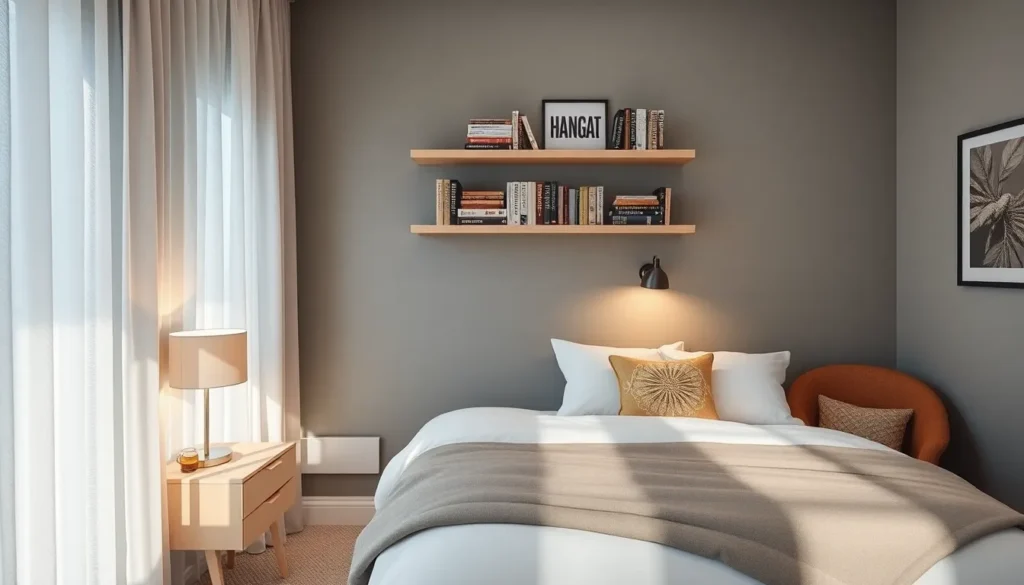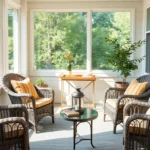Small bedrooms don’t have to feel cramped or uninspiring. We’ve discovered that with the right design strategies and creative answers, even the tiniest spaces can become stylish sanctuaries that rival larger rooms. Whether you’re working with a studio apartment or a compact guest room, smart decorating choices can transform your space into something truly special.
We understand the unique challenges that come with small bedroom design. Limited square footage often means making tough decisions about furniture placement, storage answers, and decorative elements. But, these constraints can actually spark incredible creativity and lead to more intentional design choices.
The key lies in maximizing every square inch while maintaining a sense of style and comfort. From clever storage hacks to optical illusions that make rooms appear larger, we’ll share proven techniques that interior designers use to create stunning small bedrooms. You’ll discover how to turn your space’s limitations into its greatest strengths.
Maximize Vertical Space With Smart Storage Solutions
We’ve discovered that thinking upward rather than outward transforms cramped bedrooms into organized havens. Smart vertical storage answers can increase your usable space by up to 40% without expanding your room’s footprint.
Install Floating Shelves Above the Bed
Floating shelves above your headboard create instant storage for books, decorative items, and bedtime essentials without consuming precious floor space. We recommend installing shelves 18 to 24 inches above your headboard to ensure comfortable access while lying down.
Choose shelves that match your room’s aesthetic, such as reclaimed wood for rustic charm or sleek metal brackets for modern appeal. Place frequently used items like reading glasses, phone chargers, and nighttime skincare products on lower shelves for easy reach. Display decorative objects like small plants, framed photos, or candles on higher shelves to add personality without creating clutter.
Consider installing LED strip lighting underneath each shelf to provide ambient lighting and highlight your displayed items. This dual purpose solution eliminates the need for bulky table lamps while creating a cozy atmosphere perfect for reading or relaxing.
Use Under-Bed Storage Containers
Under bed storage containers transform the often wasted space beneath your mattress into valuable storage real estate. We suggest measuring your bed’s clearance height before purchasing containers to ensure proper fit and easy access.
Rolling storage boxes work exceptionally well for seasonal clothing, extra bedding, and shoes since you can effortlessly pull them out when needed. Vacuum sealed bags maximize storage capacity for bulky items like comforters, winter coats, and sweaters by reducing their volume by up to 75%.
Drawer style containers offer organized compartments for smaller items like accessories, undergarments, and electronics. Label each container clearly to maintain organization and prevent unnecessary searching through multiple boxes.
Platform beds with built in storage drawers provide seamless integration while maintaining your room’s clean aesthetic. These beds typically offer 4 to 6 large drawers that can accommodate everything from clothing to household linens.
Hang Wall-Mounted Nightstands
Wall mounted nightstands free up floor space while providing essential bedside storage and surface area. We position these floating units 24 to 27 inches from the floor to align perfectly with standard mattress heights for comfortable access.
Choose nightstands with built in drawers or shelves to maximize storage capacity for bedtime essentials like books, medications, and personal items. Wireless charging pads integrated into the surface eliminate cord clutter while keeping your devices powered throughout the night.
Install matching nightstands on both sides of the bed to create visual balance and ensure both partners have adequate storage and surface space. Consider units with integrated lighting or USB ports to reduce the need for additional accessories on your bedside surfaces.
Floating nightstands work particularly well in rooms with limited walking space since they don’t obstruct foot traffic around the bed. This design choice creates an open, airy feeling while maintaining full functionality for your nighttime routine.
Create the Illusion of Space With Strategic Lighting

Building on our vertical storage strategies, we’ll now explore how lighting can transform your small bedroom’s atmosphere and perceived size. Strategic lighting techniques make rooms feel larger and more inviting while maximizing functionality.
Install Wall-Mounted Lighting Fixtures
Wall-mounted sconces and pendant lights free up valuable floor and surface space that traditional table lamps consume. These fixtures direct light upward toward vertical surfaces, drawing the eye toward the ceiling and creating the illusion of height. Semi-flush ceiling fixtures work particularly well in bedrooms with low ceilings, providing adequate illumination without overwhelming the space. Cordless lamps offer versatility for renters or those who prefer flexible arrangements without permanent installation.
Layer Different Light Sources
Layering combines three distinct lighting types: ambient, task, and accent lighting for maximum impact. Ambient lighting provides overall room illumination through ceiling fixtures or wall sconces. Task lighting supports exact activities like reading through bedside lamps or adjustable wall lights. Accent lighting highlights architectural features, artwork, or decorative elements using spotlights or LED strips.
Multiple small light sources create a more ever-changing atmosphere than single bright fixtures, preventing the cave-like feeling common in small spaces. We recommend using dimmable options to adjust brightness levels throughout the day, creating different moods while maintaining functionality.
Add LED Strip Lights Under Furniture
LED strip lights placed under beds, nightstands, or floating shelves create a soft, indirect glow that makes furniture appear to float. This floating effect enhances the perception of space by eliminating visual weight at floor level. Modern LED strips offer customizable color options, allowing you to match your room’s aesthetic or create ambient lighting for relaxation.
These energy-efficient lights install easily with adhesive backing and consume minimal electricity compared to traditional bulbs. Under-bed lighting proves particularly effective for nighttime navigation without disturbing sleep partners.
Use Mirrors to Reflect Natural Light
Mirrors amplify both natural and artificial light sources, making bedrooms appear brighter and more spacious than their actual dimensions. Positioning mirrors opposite windows maximizes natural light reflection throughout the day. Large mirrors create the strongest impact, but even smaller decorative mirrors contribute to the overall brightness when strategically placed.
Combining mirrors with our layered lighting approach enhances the sense of depth and airiness. Mirrored furniture pieces like nightstands or dressers serve dual purposes, providing storage while reflecting light to expand visual space.
Choose Multi-Functional Furniture Pieces
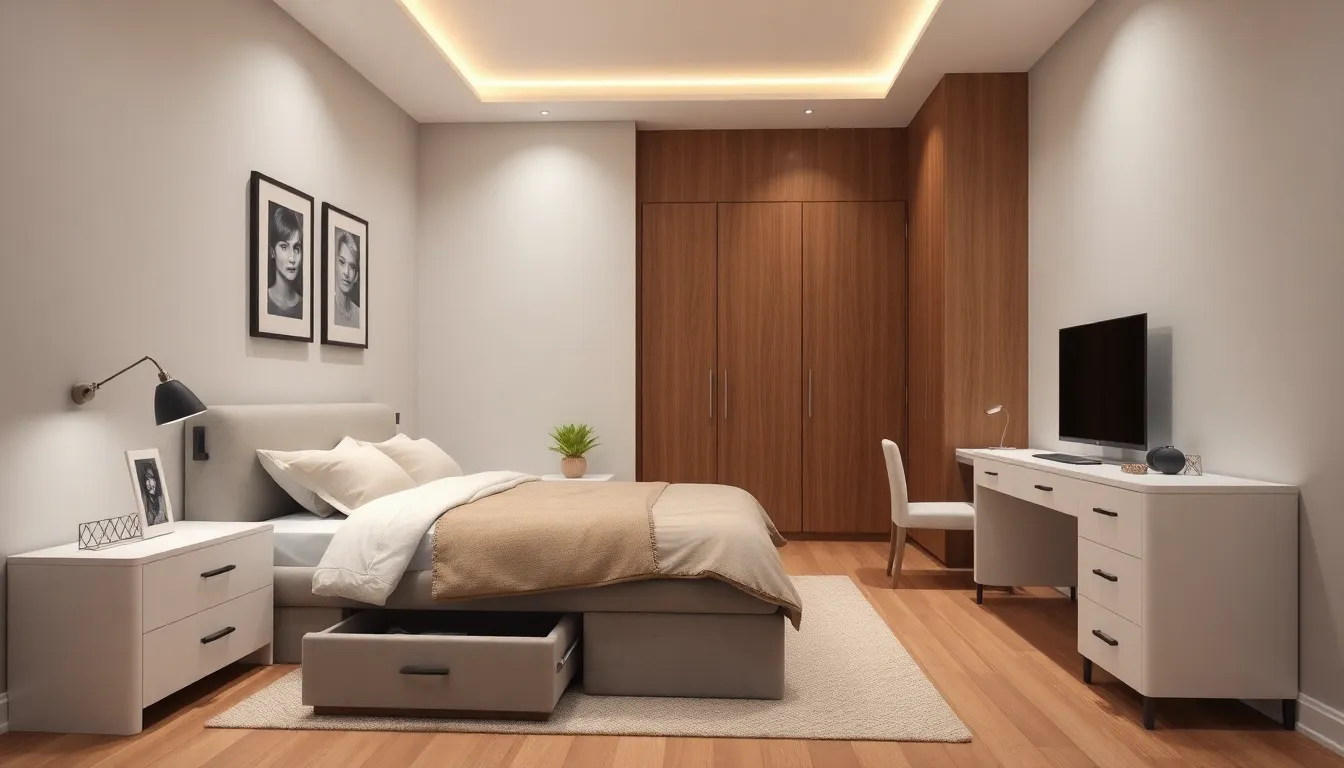
Multi-functional furniture pieces are essential for small bedrooms, allowing you to perform multiple activities without cluttering your limited floor area. These versatile pieces help maximize functionality while maintaining a streamlined aesthetic.
Invest in a Storage Ottoman
Storage ottomans serve triple duty in small bedrooms as seating, footrests, and discreet storage units. We recommend placing one at the foot of your bed to store extra blankets, pillows, or seasonal clothing. These pieces are ideal for small bedrooms where space is at a premium since they eliminate the need for separate storage containers. Choose ottomans with sturdy construction that can support your weight while providing ample hidden storage for personal items.
Select a Bed Frame With Built-In Drawers
Bed frames with built-in drawers provide immediate, hidden storage for clothing, bedding, and personal items without requiring additional floor space. We suggest choosing frames with deep drawers that can accommodate bulky items like comforters and winter clothes. This storage solution eliminates the need for bulky dressers and maintains a streamlined look in your bedroom. Platform beds with integrated drawers are particularly effective since they offer multiple storage compartments while keeping everything easily accessible.
Use a Desk That Doubles as a Vanity
Desks that transition between work and beauty functions reduce the need for separate pieces in cramped quarters. We recommend selecting furniture with flip-top mirrors or integrated makeup storage to maximize versatility. These pieces work perfectly for morning routines and evening work sessions without requiring dedicated space for each activity. Choose desks with built-in organizers and drawers to keep both office supplies and beauty products neatly stored and easily accessible.
Embrace Light and Neutral Color Schemes
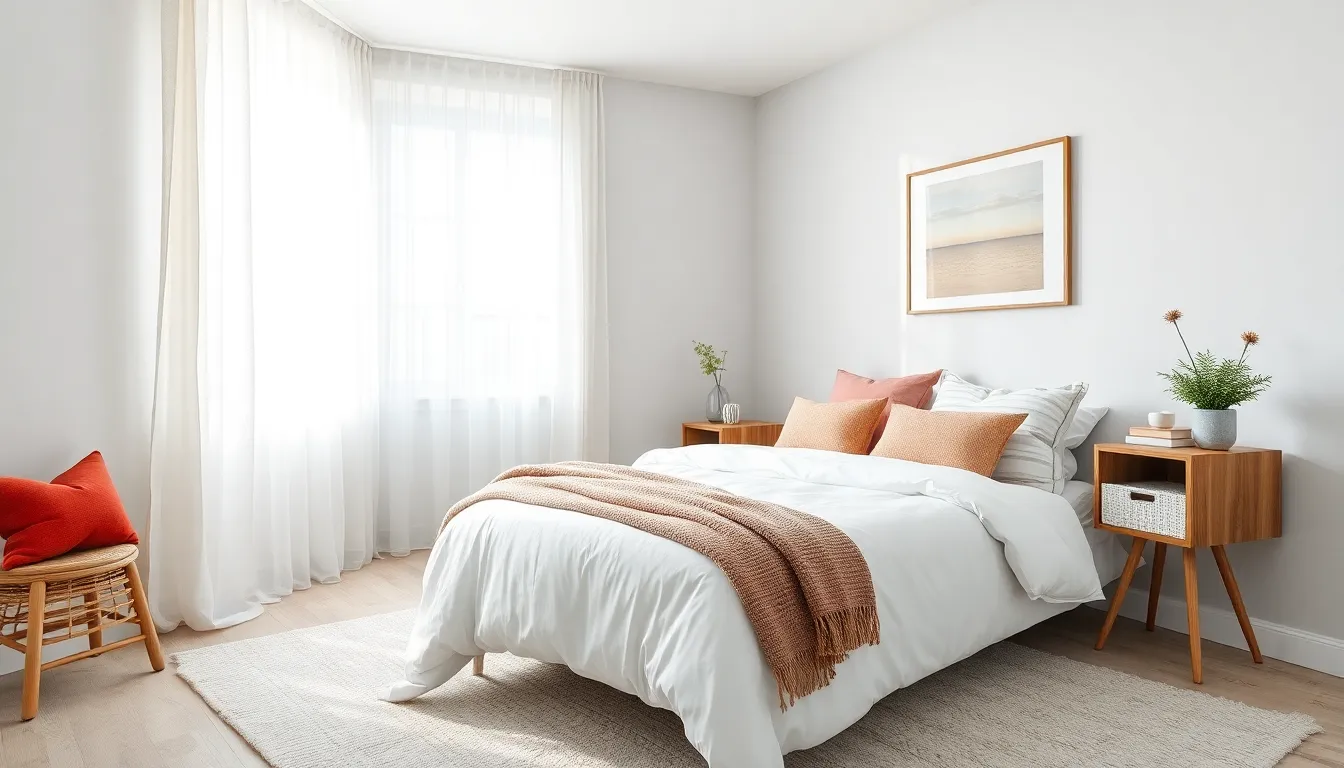
Creating an illusion of spaciousness in small bedrooms starts with strategic color choices. Light and neutral palettes reflect natural light more effectively than darker hues, making compact spaces feel larger and more inviting.
Paint Walls in Soft, Airy Colors
Soft grays transform small bedrooms into serene retreats that feel significantly more spacious than their actual square footage. We recommend choosing pale blues or gentle pastels as wall colors because they create an immediate sense of openness while reflecting available natural light throughout the day. Light colored walls act as a foundation for visual expansion, preventing the cramped feeling that darker shades often create in compact spaces.
These airy color choices serve as versatile backdrops for furniture and decor without overwhelming the eye. Painting walls in these gentle hues helps establish a calm environment that supports both relaxation and functionality in limited square footage.
Incorporate White and Cream Bedding
White bedding creates an instant sense of cleanliness and cohesion that enhances the overall spacious feeling we’re trying to achieve. Cream colored linens work equally well, providing warmth while maintaining the airy ambiance that makes small bedrooms feel more open and inviting.
These neutral bedding choices prevent visual clutter that can make compact spaces feel even smaller. We find that light colored bedding naturally draws the eye upward, creating vertical emphasis that contributes to the illusion of height and space.
Add Subtle Color Through Accessories
Throw pillows in vibrant hues provide the perfect opportunity to inject personality without overwhelming your carefully curated neutral palette. We suggest incorporating colorful accessories like wall art, area rugs, or curtains as strategic accent pieces that add visual interest while maintaining the room’s spacious feel.
Patterns and textures in these smaller decorative elements create depth and variety without compromising the calming effect of your primary color scheme. Small accessories allow you to experiment with seasonal colors or personal preferences while keeping the foundation neutral and timeless.
Utilize Every Corner and Nook
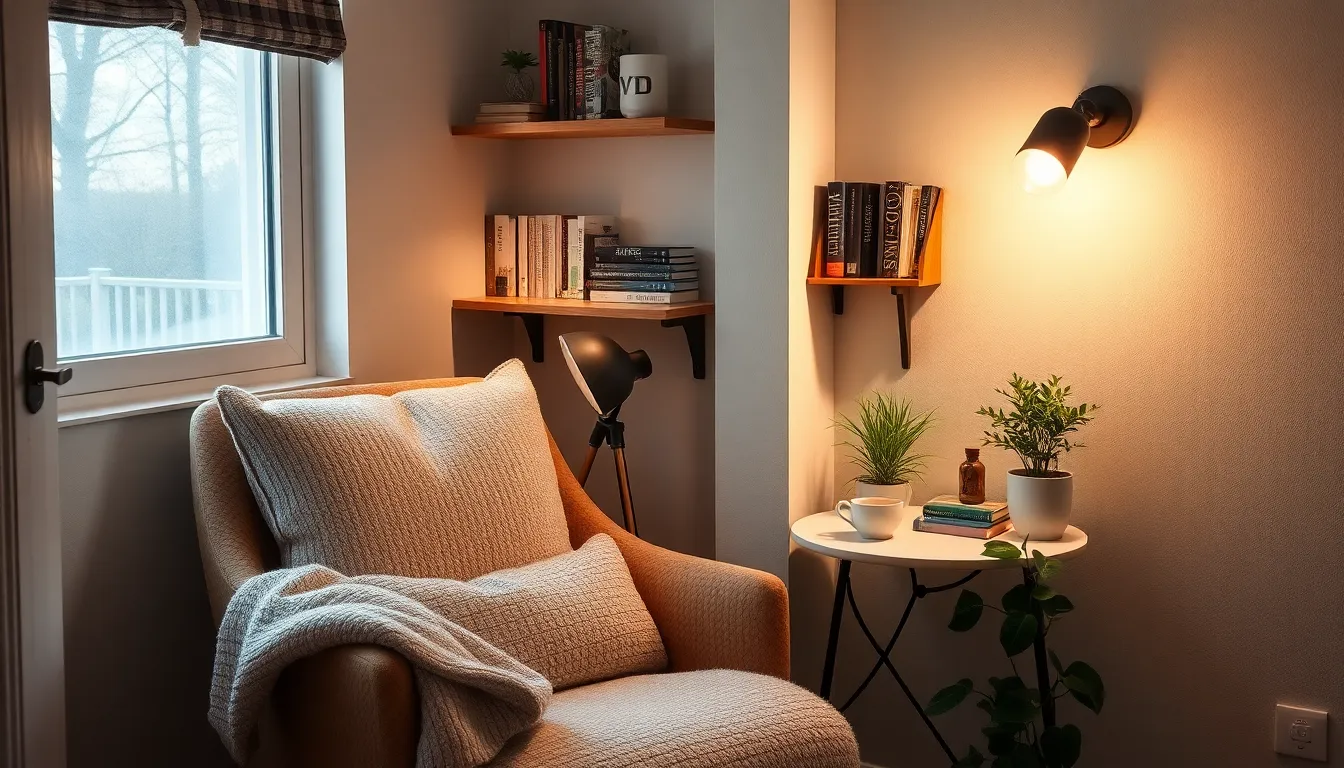
Continuing our space-maximizing journey, we now focus on transforming the often-neglected corners and unused areas of your small bedroom. Every corner represents untapped potential that can add both functionality and style to your limited square footage.
Transform Corners Into Reading Nooks
Transform those empty corners into cozy reading retreats by adding a comfortable chair or built-in bench with plush cushions. Place a wall-mounted sconce or compact table lamp nearby to create perfect reading light without claiming precious floor space. Design the nook with soft throw pillows and a small side table for your coffee or book collection. Incorporate a small basket underneath for storing magazines or blankets to keep the area organized. Choose furniture pieces that complement your bedroom’s color scheme to maintain visual harmony throughout the space.
Install Corner Shelving Units
Install vertical corner shelving to capitalize on space that typically goes unused in small bedrooms. Mount floating corner shelves at varying heights to create visual interest while providing storage for books, plants, or decorative items. Select open shelving designs that maintain the room’s airy feel rather than bulky closed units that can make corners feel cramped. Position frequently used items on lower shelves for easy access, while decorative pieces can occupy higher levels. Consider triangular corner shelves that fit snugly into the angle, maximizing storage capacity without protruding into the room’s main pathways.
Create a Mini Workspace in Unused Areas
Create functional workspaces in forgotten alcoves or narrow corners by installing floating desks or compact corner desk units. Position these mini offices near windows whenever possible to take advantage of natural light for better productivity and mood. Add a comfortable desk chair that tucks completely under the workspace when not in use to maintain clear walking paths. Install wall-mounted organizers or small shelving above the desk area to keep supplies accessible yet tidy. Include a small table lamp or adjustable wall sconce to ensure adequate task lighting during evening work sessions.
Implement Space-Saving Closet Organization

Closet organization becomes crucial when we’re working with limited bedroom space. Strategic organization techniques can transform even the smallest closet into an efficient storage powerhouse that keeps our belongings accessible and our bedroom clutter-free.
Use Slim Hangers to Maximize Rod Space
Slim hangers represent one of the most effective upgrades we can make to our closet organization system. These space-saving alternatives take up significantly less horizontal space compared to bulky traditional hangers, allowing us to hang more garments on the same rod length.
Switching to non-slip slim hangers instantly increases our hanging capacity while keeping clothes properly aligned and wrinkle-free. We’ll notice our closet appears less cluttered and becomes much easier to browse through our wardrobe options. The streamlined appearance also creates a more organized visual that makes our small bedroom feel more spacious overall.
Install Closet Door Organizers
Door organizers transform the often-overlooked interior surface of our closet doors into valuable storage real estate. We can use this vertical space to store shoes, scarves, belts, jewelry, and other accessories that typically consume precious shelf or drawer space.
These organizers come in various configurations including hooks, fabric pockets, and small mounted shelves designed to keep frequently used items visible and within easy reach. Installing door organizers helps us free up interior closet space for larger items while ensuring our accessories remain organized and accessible. We’ll find that keeping smaller items on the door prevents them from getting lost in the back of shelves or buried in drawers.
Add Shelf Dividers for Better Organization
Shelf dividers prevent our carefully folded clothes, bags, and linens from toppling over into messy piles that become difficult to manage in tight spaces. These simple organizational tools create designated sections on each shelf, ensuring every category of item maintains its own organized space.
Using shelf dividers allows us to maximize vertical shelf space more efficiently by creating stable stacks that won’t collapse when we remove items. We can group similar items together while maintaining easy access to everything we need. This organizational method helps us use every inch of available closet space while keeping our belongings neat and findable.
Design With Minimalist Principles

Minimalist design transforms small bedrooms into serene, spacious retreats by embracing simplicity and functionality. This approach creates calm, uncluttered spaces that feel larger than their actual square footage while maintaining visual clarity and peace.
Declutter and Keep Only Essentials
Minimizing belongings becomes crucial in small bedrooms to prevent crowding and preserve openness. We recommend keeping only items that serve essential functions or spark genuine joy, as excessive possessions quickly overwhelm limited square footage.
Clear surfaces regularly to maintain the neat environment that promotes relaxation and visual breathing room. Storage spaces need frequent decluttering sessions to prevent accumulation of unnecessary items that steal precious space.
Remove duplicate items like extra pillows, redundant books, or multiple charging cables that create visual noise without adding value. Every object in your minimalist bedroom should earn its place through function or meaningful connection.
Establish daily tidying routines to maintain the clutter free aesthetic that makes small spaces feel expansive and peaceful.
Choose Clean-Lined Furniture
Select furniture pieces with simple, streamlined designs that maximize floor space while reducing visual bulk in your compact bedroom. Platform beds and low profile bed frames create the foundation for minimalist aesthetics while preserving valuable square footage.
Floating nightstands mounted on walls save floor space effectively while providing functional surfaces for bedside essentials. These wall mounted pieces keep rooms feeling light and airy compared to traditional floor standing alternatives.
Compact side tables with minimal detailing maintain the uncluttered look essential to minimalist design principles. Built in storage furniture offers hidden organization without adding visual weight to your small space.
Choose pieces with straight edges and geometric shapes rather than ornate curves or decorative elements that compete for attention in tight quarters.
Limit Decorative Items to Key Pieces
Incorporate only meaningful decorative elements that add interest without cluttering your minimalist small bedroom space. Black and white photography, miniature art pieces, or sculptural accents provide visual focal points while maintaining clean aesthetics.
Functional lighting serves double duty as both illumination and decor in minimalist bedrooms. Wall mounted sconces and architectural reading lamps complement the streamlined aesthetic while adding necessary warmth to pale neutral palettes.
Small textiles like lightweight canopies or carefully chosen bedding add texture and softness without overwhelming compact spaces. These fabric elements introduce comfort while respecting minimalist boundaries.
Display collections sparingly by choosing one or two meaningful pieces rather than filling surfaces with many small objects that create visual chaos in tight quarters.
Make Bold Statements With Accent Walls
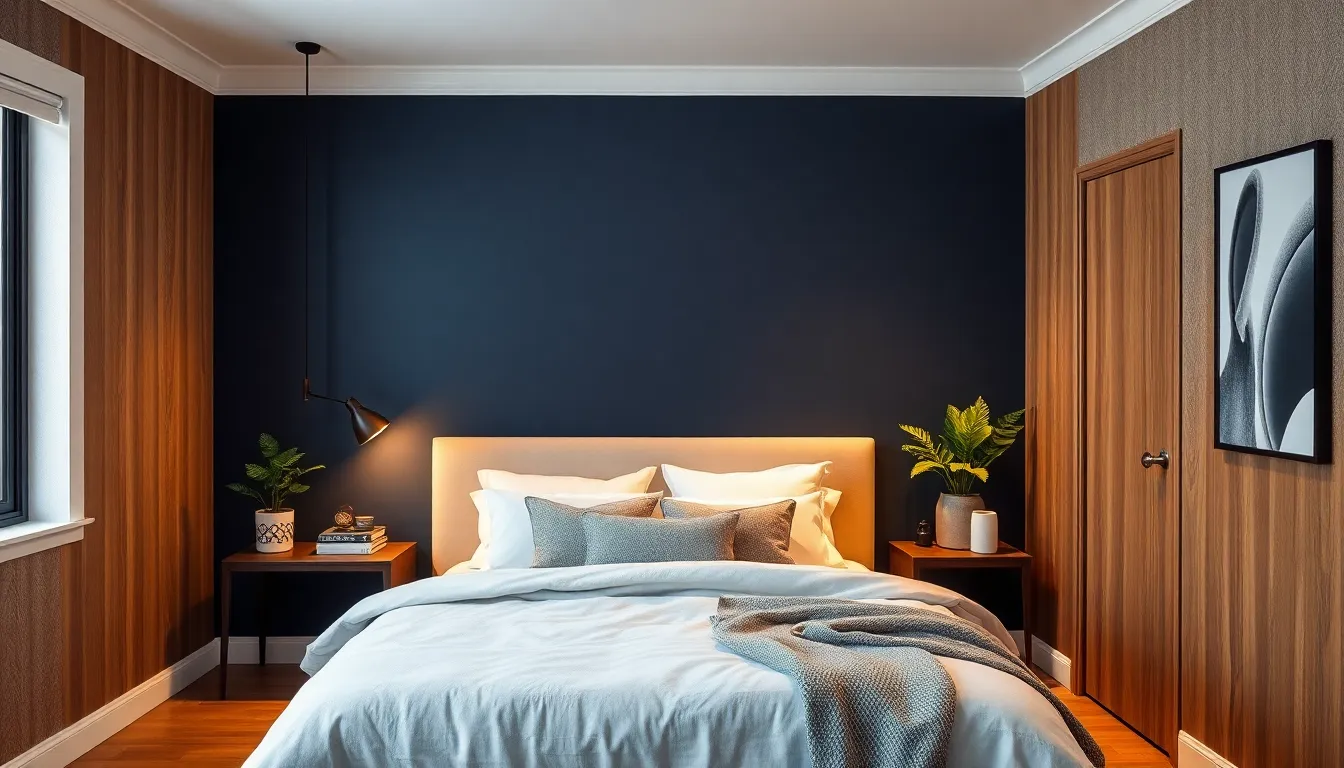
Accent walls transform small bedrooms by creating powerful focal points that draw the eye and add instant character. We’ll explore how strategic wall treatments can make your compact space feel intentionally designed and visually captivating.
Create Depth With Textured Wallpaper
Textured wallpaper adds dimension that makes flat walls come alive in small bedrooms. Plastered finishes create tactile surfaces that invite touch while adding visual weight to your space. Grasscloth wallpapers bring natural texture that catches light beautifully throughout the day.
Geometric patterns work exceptionally well in compact rooms because they create movement without overwhelming the space. We recommend using consistent color palettes when selecting textured wallpaper to maintain cohesion rather than creating visual clutter.
Embossed designs offer subtle depth that transforms plain walls into inviting surfaces. The cocooning atmosphere these textures create makes small bedrooms feel intimate and layered rather than cramped.
Use Dark Colors Strategically
Dark colors add sophistication and intimacy when applied thoughtfully in small bedrooms. Deep navy walls create enveloping spaces that feel restful and dramatic without shrinking the room visually. Charcoal accent walls work particularly well behind headboards where they frame the bed beautifully.
Balance becomes crucial when working with darker hues in compact spaces. We suggest pairing dark walls with adequate lighting and lighter furnishings to prevent the room from feeling closed in. Rich burgundy or forest green accent walls create depth while maintaining warmth.
Dark ceilings can actually make small bedrooms feel more spacious by drawing attention upward. The key lies in combining these bold color choices with textured finishes that add drama without overwhelming your limited square footage.
Install Wood Paneling for Visual Interest
Wood paneling introduces natural warmth that enhances coziness in small bedrooms. Vertical shiplap behind the headboard creates a striking focal point while adding rustic charm to your space. Horizontal board and batten works beautifully across entire walls when you want to create modern farmhouse appeal.
Reclaimed wood panels bring organic texture that complements various decor styles from industrial to Scandinavian. The natural grain patterns add visual interest without requiring additional wall decor.
Painted wood paneling offers versatility while maintaining texture and depth. We recommend sage green or soft gray painted panels for a fresh take on traditional wood treatments. These finishes bring character to small bedrooms while keeping the space feeling bright and airy.
Incorporate Smart Technology Solutions
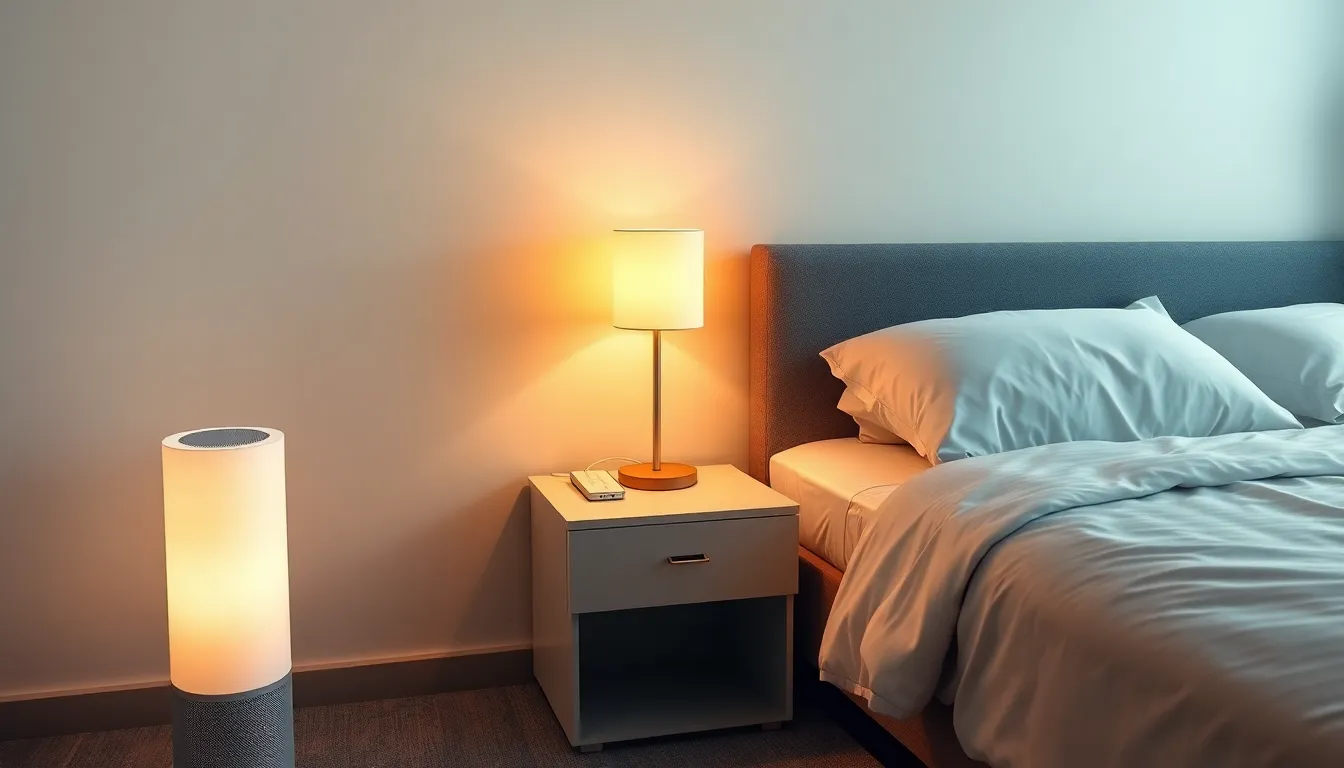
We’ve found that smart technology transforms small bedrooms into efficient, comfortable spaces by automating daily routines and centralizing device controls.
Use Wireless Charging Nightstands
Wireless charging nightstands eliminate cord clutter while providing dedicated charging spots for phones, tablets, and watches. These innovative furniture pieces streamline your bedside area by removing the tangle of charging cables that typically accumulate on traditional nightstands. Many models feature additional USB ports for extra convenience, allowing you to charge multiple devices simultaneously without sacrificing valuable surface space.
Beyond their charging capabilities, these nightstands often include built-in storage compartments or drawers that maximize functionality in small bedrooms. We recommend choosing models with integrated LED lighting or touch-sensitive controls to further enhance the modern, streamlined aesthetic of your space.
Install Smart Lighting Controls
Smart lighting allows you to control brightness, color temperature, and scheduling remotely through voice commands or smartphone apps. Touch-sensitive lamps eliminate the need for traditional switches while providing instant illumination adjustments for reading, relaxing, or waking up. Dimmable LED bulbs integrate seamlessly with smart home systems, offering customizable lighting scenarios that adapt to your daily routines.
Features like gradual sunrise simulation help regulate sleep cycles by mimicking natural light patterns throughout the day. Smart switches can replace existing wall controls without major electrical work, making them perfect for renters or those seeking simple upgrades. Voice-controlled lighting through smart hubs like Google Home or Amazon Echo adds hands-free convenience to your bedtime and morning routines.
Add Compact Air Purifiers
Compact air purifiers improve indoor air quality in limited spaces while maintaining the clean aesthetic essential for small bedroom design. Smart air purifiers can be controlled via smartphone apps, scheduled for optimal operation times, or integrated with other home automation systems for seamless functionality. These devices prove particularly effective in small bedrooms where space constraints and limited air circulation can impact sleep quality and overall comfort.
App-controlled models allow you to monitor air quality levels, adjust fan speeds, and schedule operation cycles without taking up additional space for manual controls. Many compact units operate quietly enough for nighttime use while effectively removing allergens, dust, and other airborne particles that can accumulate in smaller spaces.
Conclusion
Small bedrooms don’t have to feel cramped or compromised. We’ve shown you how strategic design choices can transform even the tiniest spaces into functional and stylish retreats that work harder for you.
From vertical storage answers to smart lighting techniques these proven strategies help you maximize every square inch. When you combine multi-functional furniture with thoughtful color choices and minimalist principles you’ll create a space that feels both spacious and personal.
Remember that technology can be your ally in small spaces. Wireless charging stations smart lighting controls and compact air purifiers add modern convenience without cluttering your carefully designed bedroom.
Your small bedroom has unlimited potential. Start with one or two strategies that resonate with you and gradually carry out others. With these designer-approved techniques you’ll create a space that proves bigger isn’t always better.
Frequently Asked Questions
How can I maximize storage space in a small bedroom?
Focus on vertical storage solutions like floating shelves above the bed, under-bed storage containers, and wall-mounted nightstands. These strategies can increase usable space by up to 40% without expanding your room’s footprint. Utilize corners with vertical shelving and transform unused areas into functional storage spaces.
What lighting techniques work best for small bedrooms?
Layer different light sources including ambient, task, and accent lighting. Install wall-mounted fixtures to free up floor space, add LED strip lights under furniture for a floating effect, and use mirrors to reflect light. This creates the illusion of height and makes the space appear brighter and more spacious.
What type of furniture should I choose for a small bedroom?
Opt for multi-functional pieces like storage ottomans that serve as seating and storage, bed frames with built-in drawers, and desks that double as vanities. Choose clean-lined furniture such as platform beds and floating nightstands to maximize floor space and reduce visual bulk.
Which colors make a small bedroom look bigger?
Use light and neutral palettes including soft grays, pale blues, and gentle pastels that reflect natural light. White and cream bedding enhances cleanliness and cohesion, while colorful accessories like throw pillows can add personality without overwhelming the limited space.
How can I organize my closet in a small bedroom?
Use slim hangers to increase hanging capacity, install closet door organizers for accessories, and add shelf dividers to keep folded items neat. These strategies maximize storage efficiency while maintaining a clutter-free appearance and ensuring easy access to your belongings.
What minimalist design principles work for small bedrooms?
Focus on decluttering and keeping only essential items. Regularly clear surfaces, choose furniture with clean lines, limit decorative items to key pieces, and incorporate functional lighting. This approach maintains openness, visual clarity, and creates a serene, spacious-feeling retreat.
How can accent walls enhance a small bedroom?
Use textured wallpaper to add depth and dimension, or consider dark colors for intimacy and sophistication. Wood paneling introduces warmth and visual interest. When applied thoughtfully, accent walls create powerful focal points that add character without overwhelming the limited space.
What smart technology solutions work well in small bedrooms?
Consider wireless charging nightstands to eliminate cord clutter, smart lighting controls for customizable brightness and scheduling, and compact air purifiers to improve air quality. These modern innovations enhance functionality while maintaining the streamlined aesthetic essential for small spaces.

